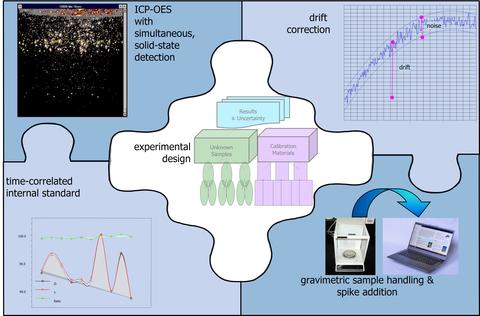Improving High-Performance Inductively-Coupled Plasma Optical Emission Spectrometry (HP-ICP-OES) Through Exact Matching
Summary
Using high-performance inductively coupled plasma optical emission spectrometry (HP‑ICP-OES), relative expanded uncertainties on the order of 0.2 % can be routinely achieved. Nevertheless, analysis results can be improved by implementing "exact matching" with the HP-ICP-OES protocol. Exact matching refers to the very careful matching of the analyte mass fractions, internal standard element mass fractions, and solution matrices of the calibration solutions to the samples. The analytical benefits of this approach are being systematically investigated. Results show that the primary benefit is mitigation of the deleterious effects of nonlinearities of the ICP-OES instrument responses to the analyte and/or internal standard element mass fractions.
Description

A thorough understanding of the analytical benefits and characteristics of the implementation of exact matching with HP-ICP-OES will enable HP-ICP-OES to be applied more effectively to a variety of NIST measurements. Such measurements include, but are not limited to, value assignment measurements for NIST Standard Reference Materials (SRMs). The accuracies and uncertainties attainable with HP-ICP-OES will be improved, benefitting NIST and many NIST customers. The findings of these studies will also enable users of HP-ICP-OES outside NIST to perform better analyses.
HP-ICP-OES was developed at NIST approximately a decade ago as a means of performing high-accuracy, low-uncertainty chemical analyses. HP-ICP-OES incorporates a robust experimental design, a unique drift correction procedure, a judiciously chosen internal standard, and gravimetric sample handling. It has become one of the main methodologies used at NIST for value assignment of SRMs that are certified for elemental content, including the SRM 3100 series single-element standard solutions. When HP-ICP-OES was first developed, it was assumed that the plasma would be sufficiently immune to matrix effects and small variations in analyte and internal standard element mass fractions to obviate any need for exact matching of standards to samples. Careful but less than exact matching was thought to be adequate. However, experience has shown that this is not necessarily the case. For many analytes, HP-ICP-OES precision and accuracy can be improved through exact matching.
Major Accomplishments
- Confirmed that exact matching can reduce bias and uncertainty in HP-ICP-OES analysis.
- Determined that the primary analytical benefit of exact matching is mitigation of the deleterious effects of instrument response nonlinearities.
Additional Technical Details
The analytical characteristics and benefits of using exact matching with HP-ICP-OES are being systematically investigated. To date, comparisons of the results of HP-ICP-OES analyses with and without exact matching have been made for thirteen elements spanning the periodic table. These results have been correlated with the degrees of linearity of the ICP-OES instrument responses to the analyte and internal standard element mass fractions. Spreadsheet modeling using synthesized data characterized by varying degrees of linearity has been performed to confirm the findings of these studies. We are now in the process of comparing the results of HP-ICP-OES analyses while exactly matching analyte and internal standard element mass fractions, but varying matrix compositions.

